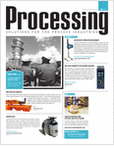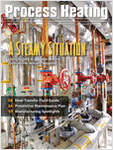Monday, February 23, 2009
Display problem ? Click HERE
Oil - Fouling Factors in [m2K/W]
| Oil Type | Fouling Factor | |
| Gasoil | 0.00009 | |
| Transformer | 0.00018 | |
| Lubrication | 0.00018 | |
| Heat Transfer oil | 0.00018 | |
| Hydraulic | 0.00018 |
Related Post
- Control Around Heat Exchanger
- FAYF - Useful Heat Transfer Equation
- Few Tips on Energy Efficient & Recovery
Labels: Fouling Factor
Sunday, February 22, 2009
Display problem ? Click HERE
Gas / Vapor - Fouling Factors in [m2K/W]
| | Gas / Vapor Type | Fouling Factor |
| Hydrogen | 0.00176 | |
| Engine exhaust | 0.00176 | |
| Steam | 0.00009 | |
| Steam with oil traces | 0.00018 | |
| Cooling fluid vapours with oil traces | 0.00035 | |
| Organic solvent vapours | 0.00018 | |
| Compressed air | 0.00035 | |
| Natural gas | 0.00018 | |
| Stable top products | 0.00018 |
Related Post
- Control Around Heat Exchanger
- FAYF - Useful Heat Transfer Equation
- Few Tips on Energy Efficient & Recovery
- Heat Transfer - Internal and External Flow
- FREE E-book........A Heat Transfer Textbook
Labels: Fouling Factor
Wednesday, February 18, 2009
Display problem ? Click HERE
Recommended :

Tubular Exchanger Manufacturers Association (TEMA) has developed a series of fouling factor for Shell and Tube (S&T). These fouling factor are generally higher than Plate Heat Exchanger (PHE), why not use S&T fouling factors to size PHE ?
Isn't this approach conservative and guarantee the performance ?
Reason being...
- Oversized Plate Heat Exchanger (PHE) required extra CAPEX and extra Space for oversized PHE
- Tubulence minimise fouling tendencies in correctly sized PHE. Oversized PHE results low actual velocity and increase potential fouling and inefficient heat transfer
- HTRI studies showed PHE fouling significant lower than Shell & Tube Heat Exchanger (S&T)... factor of 6.7
Related Post
- Cooling Water Fouling Factors
- Self Cleaning Heat Exchanger - Online Cleaning ?
- Heat Exchanger Fouling Mechanism, Prevention and Treatment...
- Why Lower Fouling factor in Plate Heat Exchanger ?
- Control Around Heat Exchanger
Labels: Fouling Factor, Heat Exchanger, Plate Heat Exchanger
Tuesday, February 17, 2009
Display problem ? Click HERE
WATER - Fouling Factors in [m2K/W]
| Water Type | Tcw < 50 ° C Tf < 120 ° C | Tcw > 50 ° C Tf > 120 ° C | ||
| v < 1 m/s | v > 1 m/s | v < 1 m/s | v > 1 m/s | |
| Sea | 0.00009 | 0.00009 | 0.00018 | 0.00018 |
| Brackish | 0.00035 | 0.00018 | 0.00053 | 0.00035 |
| Cooling tower with inhibitor | 0.00018 | 0.00018 | 0.00035 | 0.00035 |
| Cooling tower without inhibitor | 0.00053 | 0.00053 | 0.00088 | 0.00070 |
| City grid | 0.00018 | 0.00018 | 0.00035 | 0.00035 |
| River mimimum | 0.00018 | 0.00018 | 0.00035 | 0.00035 |
| River average | 0.00053 | 0.00035 | 0.00070 | 0.00035 |
| Engine jacket | 0.00018 | 0.00018 | 0.00018 | 0.00018 |
| Demineralized or distilled | 0.00009 | 0.00009 | 0.00009 | 0.00009 |
| Treated Boiler Feedwater | 0.00018 | 0.00009 | 0.00018 | 0.00018 |
| Boiler blowdown | 0.00035 | 0.00035 | 0.00035 | 0.00035 |
Tcw = Water temperature
Tf = Fluid temperature
v = Water velocity
Related Post
- Control Around Heat Exchanger
- FAYF - Useful Heat Transfer Equation
- Few Tips on Energy Efficient & Recovery
- Heat Transfer - Internal and External Flow
- FREE E-book........A Heat Transfer Textbook
Labels: Fouling Factor
Tuesday, July 29, 2008
Display problem ? Click HERE
Have you ever seen or heard about SELF CLEANING HEAT EXCHANGER ?
Recommended :
- Subscribe FREE - Oil, Gas & Petrochem Equipment
- Tips on Succession in FREE Subscription
- Subscribe FREE - Oil, Gas & Petrochem Equipment
- Tips on Succession in FREE Subscription
Operating Principle
The fouling liquid is fed upward through a vertical shell and tube exchanger that has specially designed inlet and outlet channels. Solid particles are also fed at the inlet where an internal flow distribution system provides a uniform distribution of the liquid and suspended particles throughout the internal surface of the bundle. The particles are carried by the upward flow of liquid through the tubes where they impart a mild scraping effect on the wall of the heat exchange tubes, thereby removing any deposit at an early stage of formation. These particles can be cut metal wire, glass or ceramic balls with diameters varying from 1 to 4 mm. At the top of the exchanger the particles disengage from the liquid in a widened outlet channel and are returned to the inlet channel through an external downcomer and are recirculated continuously.
More excellent article and application of Self Cleaning heat exchanger :
- Zero-Fouling’ Self-Cleaning Heat Exchanger
- Principle, Industrial Applications and Operating Installations...
- Developments and Achievements in Self-Cleaning Fluidized Bed Heat Exchangers
- Cost Savings of ‘Zero Fouling’ Crude Oil Preheaters
Labels: Fouling Factor, Heat Exchanger, Shell and Tube Heat Exchanger
Sunday, July 27, 2008
Display problem ? Click HERE
 Heat exchanger fouling has been a headache problem which can not be avoided...however many of us may not aware of it mechanism, prevention and treatment....
Heat exchanger fouling has been a headache problem which can not be avoided...however many of us may not aware of it mechanism, prevention and treatment....Heat Exchanger Fouling Causes Problems In Gas and Liquid System
The article presented six (6) distinctive different mechanism causing Heat Exchangers Fouling e.g. Crystallization, Sedimentation, Chemical reaction & Polymerization, coking, Biological growth and corrosion. This article will only focus on particulate fouling. It discusses particulate fouling mechanisms, prevention and treatment. This article also presented Prediction Model for Particulate Fouling by Kern & Seaton.
by Reza Hashemi and Robert L. Brown, Jr.
Related Topics
The article presented six (6) distinctive different mechanism causing Heat Exchangers Fouling e.g. Crystallization, Sedimentation, Chemical reaction & Polymerization, coking, Biological growth and corrosion. This article will only focus on particulate fouling. It discusses particulate fouling mechanisms, prevention and treatment. This article also presented Prediction Model for Particulate Fouling by Kern & Seaton.
by Reza Hashemi and Robert L. Brown, Jr.
Related Topics
Labels: Fouling Factor, Shell and Tube Heat Exchanger
Thursday, June 12, 2008
Can't view properly ? Click HERE
 Fouling in heat exchanger is one of most challenging operation problem. It is the buildup of sediments and debris on the surface area of a heat exchanger and reduce heat transfer.
Fouling in heat exchanger is one of most challenging operation problem. It is the buildup of sediments and debris on the surface area of a heat exchanger and reduce heat transfer.Fouling will reduce heat transfer, impede fluid flow and increase the pressure drop across the heat exchanger.
Plate heat exchanger as compare to Shell & Tube Heat Exchanger showed lower fouling factor. Have you ever thought of the reasoning behind ?
This article has briefly discussed types of fouling, fouling factor used in Shell and Tube Heat Exchangers for common fluids, why lower fouling factor in plate heat exchanger (PHE) and, design consideration to reduce effects of fouling....
Related Topics
Labels: Fouling Factor, Heat Exchanger
Thursday, August 16, 2007

Fouling factor is generally used in the design to cater for heat exchanger deficiency resulted by fouling. TEMA has based on many years of experiences and experiments list out fouling factor for Shell & Tube Heat Exchanger for many services. Only TEMA subscribers are eligible to use this information. However, there are several reputable researchers & manufacturers have shared this information to the public. Following are the collection of fouling factors for different service.
- GEO-center (Plate Heat Exchanger)
- Control Around Heat Exchanger
- FAYF - Useful Heat Transfer Equation
- Few Tips on Energy Efficient & Recovery
- Heat Transfer - Internal and External Flow
- FREE E-book........A Heat Transfer Textbook
Labels: Fouling Factor, Heat Exchanger, Shell and Tube Heat Exchanger
